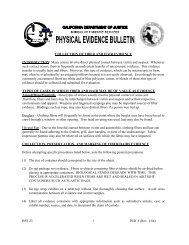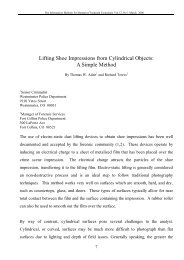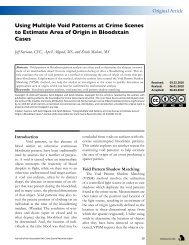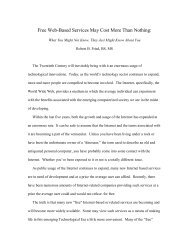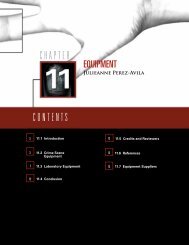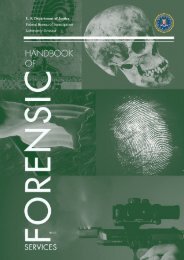PHYSICAL EVIDENCE MANUAL - Crime Scene Investigator Network
PHYSICAL EVIDENCE MANUAL - Crime Scene Investigator Network
PHYSICAL EVIDENCE MANUAL - Crime Scene Investigator Network
Create successful ePaper yourself
Turn your PDF publications into a flip-book with our unique Google optimized e-Paper software.
Physical Evidence Manual<br />
examination. Any number of paper specimens may be placed in a single<br />
envelope for submission.<br />
Any latent prints of identifiable quality will be imaged and the original lifts or<br />
evidence will be returned to the submitting agency. If the original lift is not<br />
available, non jpeg images of the latent, with a scale in the image, may be<br />
submitted. (See the Division policy on submitting digital images)..<br />
After comparisons are conducted with any known suspect’s prints or submitted<br />
inked standards, the remaining unidentified latent fingerprints will be evaluated<br />
for AFIS quality and may be searched against the AFIS database. Unidentified<br />
latent fingerprints of AFIS quality will be entered into the unidentified latent<br />
fingerprint database for future searches against the database. If identification is<br />
effected as a result of this search the submitting agency will be notified in an<br />
official laboratory report.<br />
In the event the submitting agency should identify any latent fingerprints that<br />
should be cleared for any reason, the agency should notify the laboratory so<br />
these latent fingerprints can be purged from the unidentified latent fingerprint<br />
database.<br />
Submission of Inked Prints for Comparison Purposes<br />
The investigator should take inked prints from all persons known to have<br />
legitimately handled the evidence (elimination prints) to permit comparison with<br />
any latent prints, or if the individual already has inked prints on file, list their SID<br />
number on the Form 49 when submitting the evidence.<br />
Often latent prints found at the scene of a crime involve areas of the palms,<br />
second and third joints of the fingers, and the finger sides and tips. For this<br />
reason the analyst may request that the investigator take complete inked prints<br />
(major case prints) of all ridges on the hands of suspects or persons known to<br />
have legitimately handled the evidence (elimination prints) to permit<br />
comparisons. Palm prints should always include prints of the lower finger joints,<br />
as well as an extra print of the outer edge of the palm.<br />
Inked prints for comparison with latent prints should be submitted with the<br />
evidence itself.<br />
Identifying the Deceased<br />
The responsibility for identifying deceased persons rests with the State Medical<br />
Examiners (ME) Office. The Forensic Services Division often assists the ME in<br />
identifying decomposed remains. Requests of this type should be made through<br />
the State ME’s Office.<br />
Adopted: May 2002<br />
Revisions: 6<br />
Last Revision: January 31, 2008<br />
10-5



